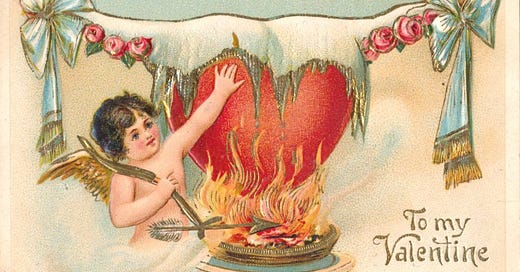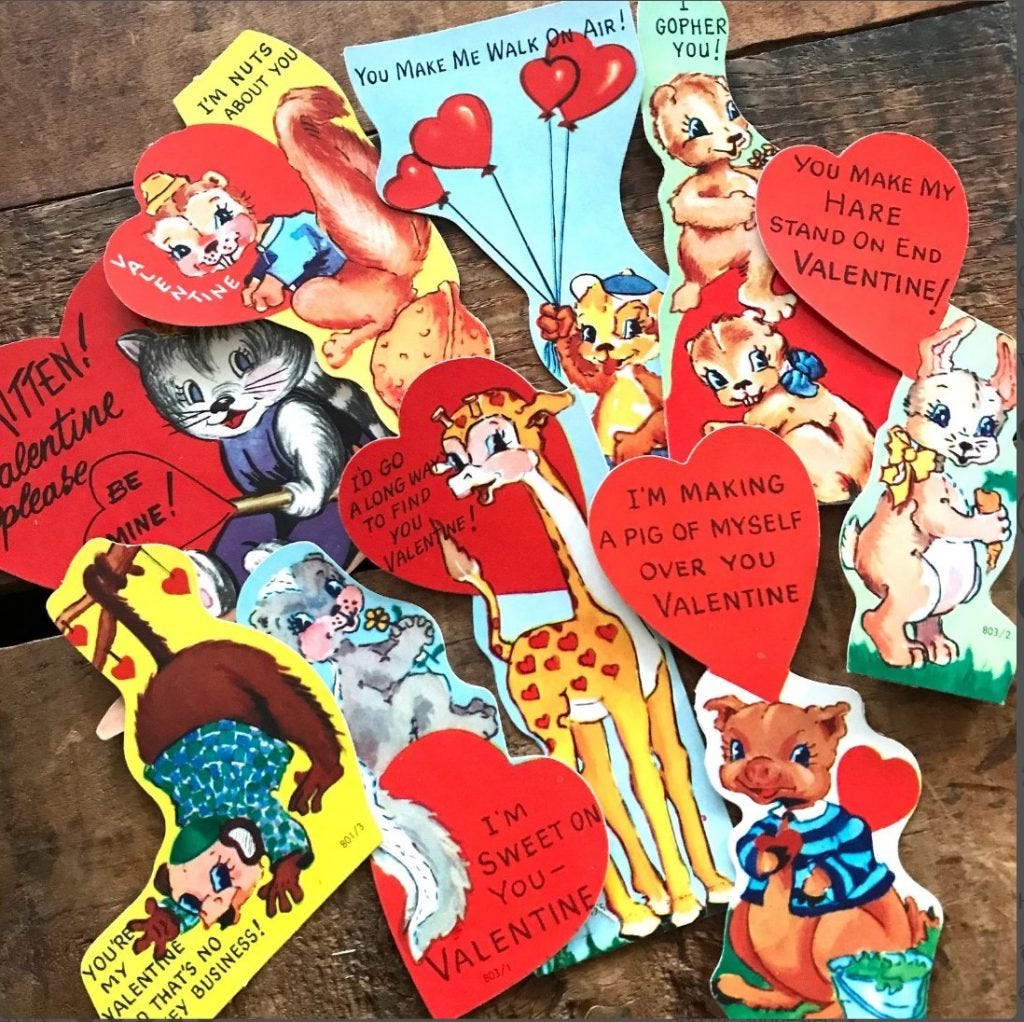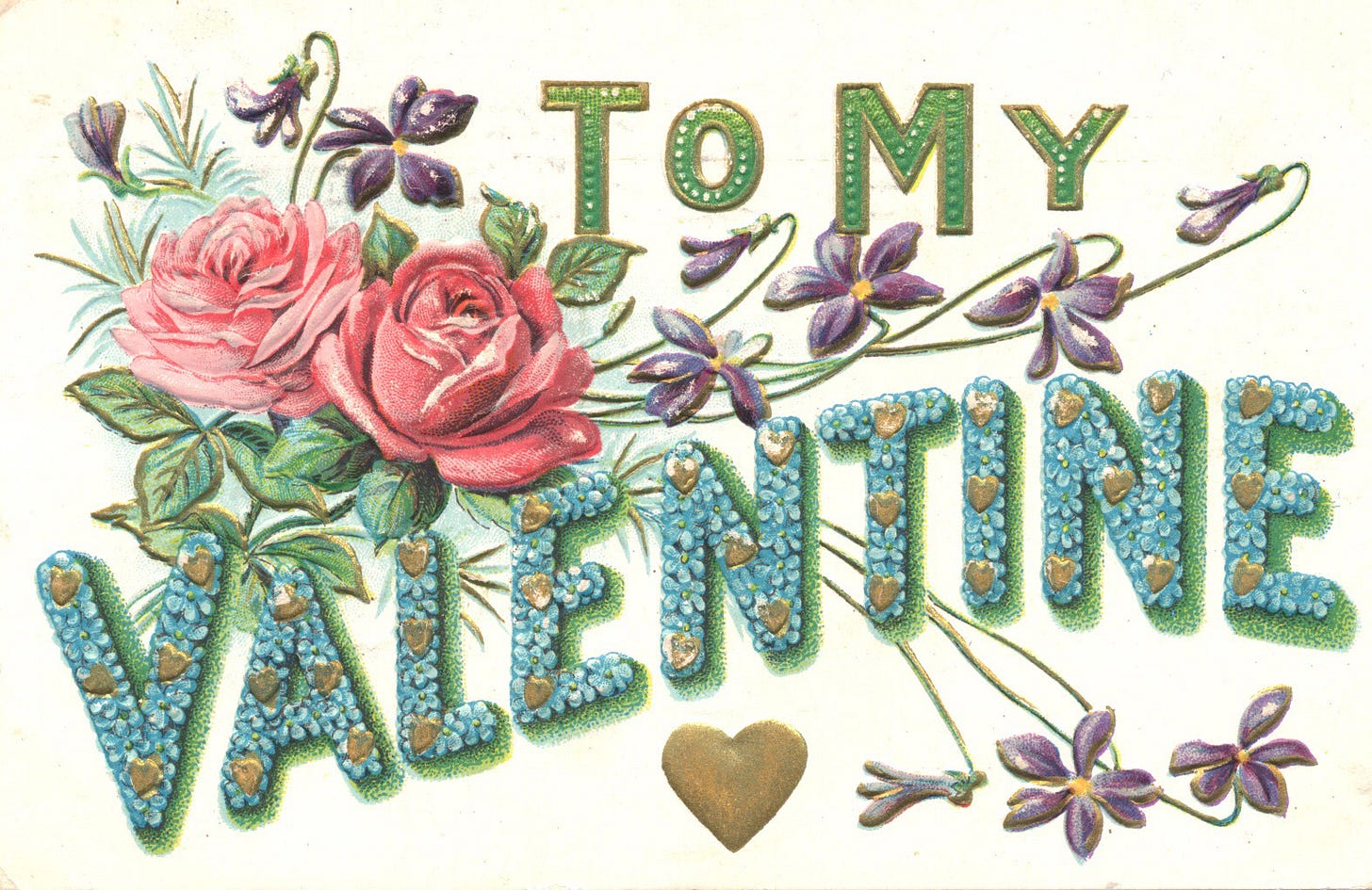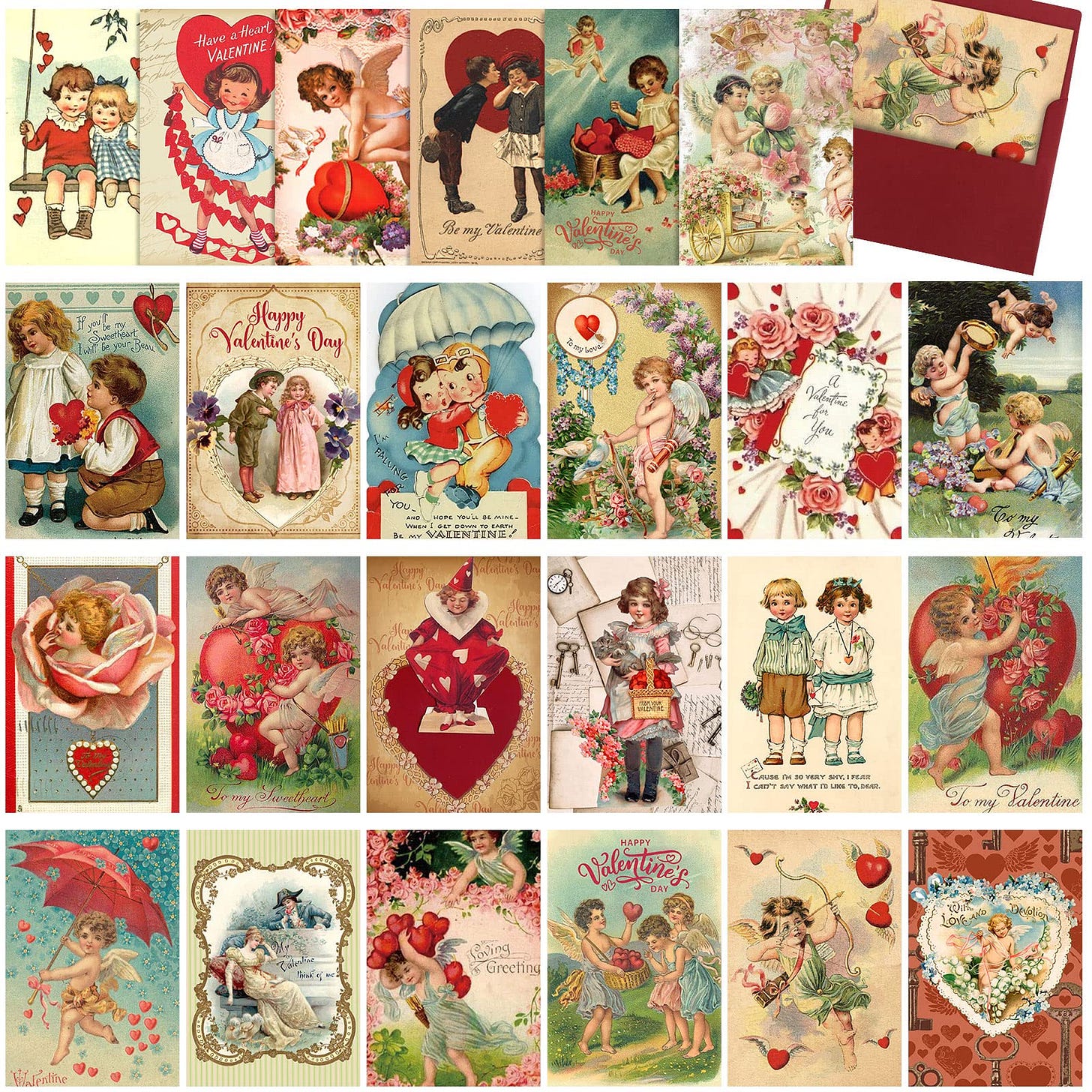Have You Ever Seen A Heart Shaped Like A Valentine?
Modern love is a paradox, worshipping the heart as its symbol while embodying everything the heart is not.
Why is the heart a symbol of Valentine’s Day and Love?
We know lots about the heart. Everything depends on it being steady, sure, controlled, never missing a beat, and sustaining a rhythm without ever stopping for a whole lifetime. The consequences of its failure, even for a moment, are dire. We might suffer terribly or even die. Worry, stress, jealousy, bad news, almost anything unexpected - these are the threats to the heart’s role in life.
The miracles of modern medicine can see it repaired, augmented, or even replaced. But it’s not something that would be undertaken lightly by anyone. It’s a path fraught with life-threatening jeopardy. The heart needs to last - for life.
The main feature of the heart is that it must be, in a word, dependable. Its strength and uninterrupted reliability through all things we experience is the quality on which our lives literally depend.
This lifelong, resilient, tireless worker, sustaining life through its quiet, unrelenting effort; this unseen beat, this deep need to trust a steady unwavering rhythm to things, doesn’t sound much like modern love and romance… or does it?
The heart as a true symbol of love is less an organ of unchecked passion or desire and more a vessel of endurance, learning, and compromise. Love is not the effortless union of two souls but the ongoing negotiation of flaws, anxieties, and histories. The heart’s true role is not to fuel wild infatuation but to sustain the quiet, steady work of understanding another person—through miscommunications, disappointments, and the humbling realization that to truly love is to accept imperfection with grace.
Yet our ideal of love has become erratic, impulsive, and fragile—chasing fireworks, demanding perfection, and collapsing at the first sign of discomfort. We celebrate passion but resist the endurance real love requires; we seek grand gestures but recoil from the small, daily labor that makes relationships last. In elevating love to a divine force beyond human effort, we have made it elusive, fleeting, and ultimately unsatisfying.
Modern love is a paradox, worshipping the heart as its symbol while embodying everything the heart is not.
What the heck is wrong with us?
Let’s review.
There are few things more confusing than a box of Valentines.
My daughter is 8. For those not in the school system these days, here are the current rules at our local elementary: Everyone gives an equal valentine to everyone. No exceptions, cards only, they must all be the same, and no special Valentines allowed.
A little research shows rules vary widely across the country. The news reports some schools have chosen to discontinue traditional Valentine's Day card exchanges to foster a more inclusive environment. For instance, some have requested that parents refrain from sending Valentine's cards or food items with their children on February 14th. This approach aims to ensure that all students feel included, regardless of their personal or cultural backgrounds. No dances, no baking, no sharing of food.
I understand the folks making these draconian rules. I’m sure there are some who vowed to grow up to be teachers for the express purpose of saving some poor little version of themselves from pain.
My 1970s, elementary school Valentine’s Day was a battlefield of awkward affections, unrequested love, and silent or sulking heartbreak. Every student brought a paper bag of tiny, mass-produced Valentine’s cards featuring cartoon characters or pun-laden declarations of devotion, carefully—or carelessly—scribbling names onto the flimsy paper. Handmade mailboxes—often decorated shoeboxes—stood ready, trembling with anticipation or dread.
For some, it was a day of triumph, receiving an overstuffed mailbox filled with heartfelt, often confusing, messages and candy. For others, it was a stark reminder of their social standing, as their shoebox sat depressingly light, containing only the obligatory cards from kids forced into fairness by well-meaning parents and teachers. The air was thick with tension—who would confess a crush, who would receive an unwelcome note, and who would be cruelly ignored?
Whether the result was being hearted by everyone or no one, a box of Valentines was ultimately confusing. The day ended with a pile of pastel-colored paper, a sugar high, and the unshakable feeling that love—at least as defined by cartoon animals and glitter glue—was as confusing and inscrutable as ever.
Fudge and rice crispy squares could do little to mend bruised egos and broken hearts, but the day was a rite of passage—one that left some children giddy with success and others nursing their first bitter taste of romantic rejection. By the final bell, the floor was littered with torn envelopes, crushed Lovehearts, and the unspoken realization that love, even in its simplest form, was a messy, ruthless affair.
And it doesn’t really get better from there. Valentine’s Day in the modern era has become a minefield of expectations, anxieties, and social pressures.
For teenagers, it’s often a day of high-stakes posturing—where Instagram-worthy gifts and public declarations of affection can determine social standing, while those left out are forced to nurse their wounds in silence.
In their 20s, young adults navigate the shifting landscapes of casual relationships, ghosting, and dating app culture, where the holiday can feel either like an unnecessary complication or a test of where things really stand.
For young married couples, Valentine’s Day presents its own quiet tensions—how do you celebrate love meaningfully without falling into the trap of performative romance or commercialization? What was once a day of simple gestures has morphed into a litmus test for personal worth, relationship health, and social currency, leaving many wondering if love is truly being honored or just staged for an audience.
And for older pairs… there’s the dread of forgetting… or wishing you could.
Love hurts…
The way we are taught to love in the Romantic School is by impulse, and that impulse sits on top of the trash heap of our childhood experiences.
For many of us, there’s a lot of unreconstructed anger, private rage about the way our love lives have gone.
My goal here is to turn that anger into sadness… a kind of grief that so many get love so wrong, and it is we ourselves that cause the suffering of romance. It requires diminishing our learned hope for love and replacing it with something else. It will be very difficult because there are vast industries banking on inflating our amphetamine expectations around love.
We mistake the card for the love, the chocolates for the sweetness, the flowers for the bloom of a relationship. But in doing so, we lose touch with what they were meant to celebrate: not fleeting passion, but the slow, steady fertility of long-term devotion.
In The Beginning
Valentine’s Day has its roots in both ancient Roman and early Christian traditions, evolving from a mix of mythology, martyrdom, and medieval romanticism.
Ancient Roman Origins
The earliest ancestor to Valentine’s Day was Lupercalia, a pagan fertility festival celebrated from February 13 to 15 in ancient Rome. During this festival, Roman priests called Luperci would sacrifice goats and dogs, then use their hides to whip women in the belief that it would increase their fertility. Young men and women were also paired together in a sort of lottery, sometimes leading to marriage. Those ancient festivals! Always about the fertility!
Christianization and Saint Valentine
In the 3rd century, Emperor Claudius II banned marriage for fighting age young men, believing that single soldiers fought better. A Christian priest named Valentine (or possibly multiple Valentines… this is not hardcore history) defied this order by secretly marrying couples. When he was caught, he was executed on February 14, around 269 AD. Legend says he wrote notes from prison making secret marriage matches with decorative cards signed “Your Valentine” giving rise to the tradition of love notes.
By 496 AD, Pope Gelasius I declared February 14 as St. Valentine’s Feast Day, aiming to replace the pagan Lupercalia festival with a Christian celebration. Classic Christian festival usurping.
Medieval Courtly Love & Poetry
By the Middle Ages, St. Valentine became associated with romantic love, partly thanks to Geoffrey Chaucer, who wrote in his poem Parliament of Fowls (1382) that February 14 was the day when birds found their mates. This idea spread, and the tradition of exchanging handwritten love notes began. Though it’s well worth noting that the whole thing was still about mating.
Modern Commercialization
By the 1700s, printed Valentine’s cards became popular in England, and by the 1800s, mass-produced cards took off in the U.S. thanks to advancements in commercial printing. Today, Valentine’s Day is a global celebration, heavily commercialized with chocolates, flowers, and gifts.
Why Fertility Mattered
Let’s go back to the start. We always stop the inquiry at the “Fertility Festival” and pause to imagine something ancient and sexy I think. But what is all this historic heat about fertility?
In plain language, fertility festivals and rites in ancient times were about ensuring survival. The goal was simple: make sure people, animals, and crops kept reproducing so that life continued.
More People = Stronger Society - High birth rates were necessary because many people died young due to disease, war, or poor living conditions. More births meant a stable population group, a family to believe in and trust, a strong workforce, and a larger army.
More Crops = No Starvation - People believed that the forces that governed human fertility also governed the fertility of the land. If crops failed, people starved. So rituals often combined human reproduction with prayers for abundant harvests.
More Animals = More Food & Wealth - Livestock was a major source of food, labor, and wealth. Ensuring that animals reproduced well was just as important as human fertility.
Fertility meant growing new stuff. And it was crucially important - of central interest to all sensible people.
Babies, Crops, and Livestock
Ancient people didn’t separate sex, birth, and survival the way modern society does. They saw them as part of the same cycle of life, death, and renewal. Babies, crops, and animals were inseparably connected. Fertility wasn’t just about having babies—it was about keeping everything growing. This is why their gods, festivals, and rituals often tied together sex, the earth, the seasons, and the continuation of life.
Fertility rites were not about pleasure but about responsibility—ensuring that life didn’t stop.
The Fertile Heart: Reclaiming the True Meaning of Valentine’s Day
We mistake the card for the love, the chocolates for the sweetness, the flowers for the bloom of a relationship. But in doing so, we lose touch with what they were meant to celebrate: not fleeting passion, but the slow, steady fertility of long-term devotion.
From Fertility to Frivolity
In ancient times, fertility festivals weren’t about fleeting romance; they were about survival. The Lupercalia, the Roman festival that preceded Valentine’s Day, was a riotous, physical ritual designed to ensure that people, animals, and crops flourished.
To those early societies, fertility meant life itself: more people meant stronger tribes; more crops meant full bellies; more animals meant more wealth and security. The cycle of birth, growth, and renewal wasn’t just an abstract concept—it was the foundation of civilization.
Love, in its oldest sense, was not just about desire, but about continuity. A good match wasn’t simply a passionate one—it was one that could sustain a household, raise strong children, and provide security. Love, as the ancients understood it, was something built, not something fallen into.
Love In The Age of Romance
Alain deBotton - The most insightful action-packed 5-minute lesson in love you will ever experience.
In the Romantic Era, true love is a full-time job that you will surely be fired from.
deBotton concludes that in a world where all of us are flawed and broken love is really about going easy on each other and taking a charitable view of everything that is terrible.
The Romantic Era and the Illusion of Love
The Romantic Era. When love became modern. As Alain de Botton argues, over the last 250 years the Romantics reshaped love into something dramatic, idealized, and ultimately impractical. And it’s not history. We are still living in that era, but just with slightly less poetry.
Instead of seeing love as a slow-growing tree, they framed it as a lightning strike. Love became a quest for deep passion, for soulmates, for an impossible and everlasting emotional high. The old, practical aspects of love—the contract, companionship, duty, shared labor—began to seem mundane, even oppressive.
Along with this shift came a new reliance on symbols: poetry, gifts, and grand gestures. These things had once been expressions of love, but now they became love itself. The gestures overshadowed the substance.
We came to mistake the symbol for the thing symbolized.
(I know I write about this a lot. In my world view, it is the most common of human themes.)
Valentine’s Day: A Celebration of Symbols
By the time Valentine’s Day evolved into its modern form, the transformation was complete. The holiday became a performance: the right card, the right dinner, the right gift. Love became something to be proven rather than lived. We stopped celebrating the slow, fertile growth of a life shared together and started chasing the fireworks of early romance. And, inevitably, we became disappointed. No dinner reservation or bouquet of roses can substitute for the deep pleasure of knowing someone fully, of having built something real over time.
Reclaiming Fertile Love
But there is another way to celebrate love—a way that returns to its roots.
Love is not an event. It is a process. Like the land, it has to be tended. The ancients understood this. They poured wine into the soil and made offerings to their gods, knowing that abundance required care, patience, and work. Somewhere along the way, we traded that wisdom for a heart-shaped box of chocolates bought at the pharmacy on the way to a swiped-right date.
What Would Wendell Berry Say about Valentines?
Love is not about spectacle or fleeting passion, but about seasons—of planting, waiting, harvesting, and beginning again. In a world that has turned romance into performance, Berry would urge us to step away from the noise, to love as farmers love the soil: with patience, care, and an abiding commitment to the slow, sacred work of growing something real. Wendell Berry might remind us that love, like the land, is not a moment but a lifetime of tending.
The Preacher Might Quote From Scripture.
A preacher might turn to Ecclesiastes 4:9-10, the book that tells us that to everything there is a season: "Two are better than one, because they have a good return for their labor: If either of them falls down, one can help the other up. But pity anyone who falls and has no one to help them up." These words remind us that love and marriage are not about fleeting romance but about shared strength, resilience, and support. Love is not just an emotion but a sacred bond where each lifts the other, ensuring that neither walks alone through the trials and blessings of life.
What about the Language of Love?
Love is not a noun; it is best understood as a verb. To love, to be loved—these are acts of service, not just feelings. Love is a responsibility, an ongoing commitment, a choice made every day. In the human world, as among many animals, it is the duty and destiny of a lifetime.
So what if, this Valentine’s Day, we returned to love’s oldest form? What if, instead of grand gestures, we focused on small acts of tending, mending, and marriage? —the things that actually make love fertile.
In a world where love is grown, not found, maybe the best Valentine’s gift is a love that beats like our real hearts—steady, strong, and quiet.
POSTSCRIPT
Love and the Ancient Mystery Schools
What does love really mean and intend?
The ancient mystery schools, as described by thinkers like W. L. Wilmshurst in The Meaning of Masonry, were centers of esoteric wisdom where initiates sought deeper truths about existence, the divine, and human purpose. Love and marriage were not seen as mere social contracts but as inseparable sacred unions reflective of cosmic harmony. To those invested in the mysteries of fertility, love, and marriage were inseparable aspects of a divine order, mirroring the generative forces of nature and the balance of masculine and feminine principles. The rites and teachings of these schools often emphasized the role of love as a unifying force, not only between individuals but within the greater fabric of creation itself.
In the ancient mystery traditions, love was a bonding. A marriage of two people in the fullest sense. It means a new beginning (an initiation); a break-away from an old method and order of life and the entrance upon a new one of larger self-knowledge, deepened understanding, and intensified virtue. It means a transition from the merely natural state and standards of life towards a regenerating and super-natural state and standard where we are as one with another and by extension all – past present and future.
It means the awakening of those hitherto dormant higher faculties of the soul, which endue their possessors with "light" in the form of new enhanced consciousness and enlarged perception of connection.
And lastly, you can tell I’m quoting now, “it means that the postulant will henceforth dedicate and devote their life to the other rather than to their own or any other service.”
To comply with this definition of marriage—which it might be useful to apply as a test not only to those who seek admission today, but to ourselves who are already within it—it is obvious that special qualifications of mind and intention are essential and that it is not necessarily the ordinary person of the world who is either properly prepared for, or likely to benefit in any vital sense by, reception into it.
For marriage means this or it means nothing worth the serious pursuit of thoughtful people; nothing that cannot be pursued as well outside the marriage as within it. It proclaims the fact that there exists a higher and more secret path of life than that which we normally tread, and that when the outer world and its pursuits and rewards lose their attractiveness for us and prove insufficient to our deeper needs, as sooner or later they surely will, we are compelled to turn back upon ourselves, to seek and knock at the door of a world within; and it is upon this inner world, and the path to and through it, that marriage promises light, charts the way, and indicates the qualifications and conditions of progress.
This is the sole aim and intention of love and marriage, which to those interested in fertility were two inseparable things. To paraphrase Wilmshurst’s reflections on the Ancient Mystery Schools: Behind its more elementary and obvious symbolism, behind its counsels to virtue and conventional morality, behind the platitudes and sententious phraseology (which nowadays might well be subjected to competent and intelligent revision) it is a scheme that, as will be shown later, reproduces for the modern world the main features of the Ancient Mysteries - an epitome or reflection at a far distance of the once universal connection humans had to all the natural and spiritual world around us.
More deBotton… You Will Marry The Wrong Person - And That’s OK.









